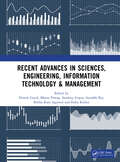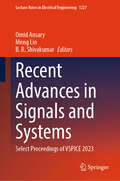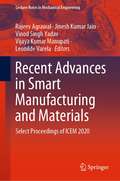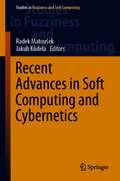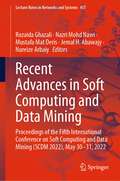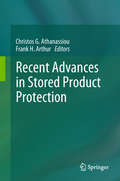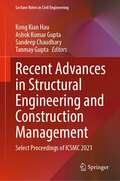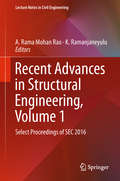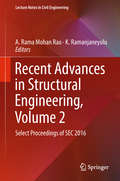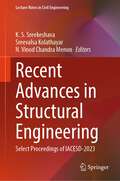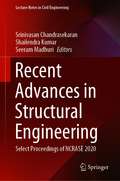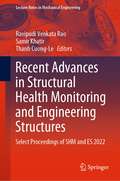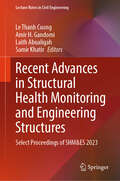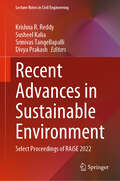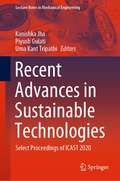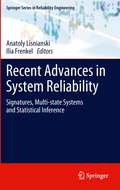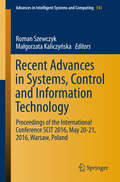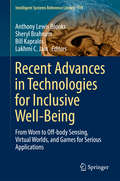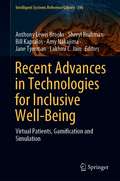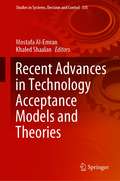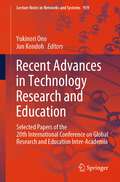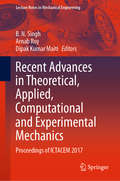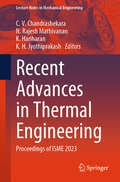- Table View
- List View
Recent Advances in Robotics and Automation
by Dale Carnegie Donald Bailey Gourab Sen Gupta Serge DemidenkoThere isn't a facet of human life that has not been touched and influenced by robots and automation. What makes robots and machines versatile is their computational intelligence. While modern intelligent sensors and powerful hardware capabilities have given a huge fillip to the growth of intelligent machines, the progress in the development of algorithms for smart interaction, collaboration and pro-activeness will result in the next quantum jump. This book deals with the recent advancements in design methodologies, algorithms and implementation techniques to incorporate intelligence in robots and automation systems. Several articles deal with navigation, localization and mapping of mobile robots, a problem that engineers and researchers are grappling with all the time. Fuzzy logic, neural networks and neuro-fuzzy based techniques for real world applications have been detailed in a few articles. This edited volume is targeted to present the latest state-of-the-art computational intelligence techniques in Robotics and Automation. It is a compilation of the extended versions of the very best papers selected from the many that were presented at the 5th International Conference on Automation, Robotics and Applications (ICARA 2011) which was held in Wellington, New Zealand from 6-8 December, 2011. Scientists and engineers who work with robots and automation systems will find this book very useful and stimulating.
Recent Advances in Science, Engineering & Technology: International Conference on Recent Advances in Science, Engineering & Technology
by Nishu Gupta Milind Khanapurkar Asha Gedam Nikhil Bhave Sandeep S. JoshiThe advances in technology, engineering and science are necessary for better and sustailable life. It is not only beneficial for human growth but equally important for all the living and non living matters on the planet. Hence it is imperative to come togather and share the knowledge, innovations and developments in the technology and science happening around. The objective of 1st International Conference on “Recent Advances in Science, Engineering & Technology” (ICRASET-2023) was to provide platform to share various hypotheses, conclusions, and discoveries from students, researchers, professors, and industry experts. The conference was associated with the knowledge partners like ASM International, IEEE, IETE, ISTE, CSI and IE
Recent Advances in Sciences, Engineering, Information Technology & Management
by Dinesh Goyal Bhanu Pratap Sandeep Gupta Saurabh Raj Rekha Rani Agrawal Indra KishorThis conference covered various interdisciplinary areas such as applied science, physics, material science, and engineering. The audience got a chance to encircle the various interdisciplinary areas and people working on recent technologies in science, engineering, information technology and management. It was based on the theme of converging interdisciplinary topics into a single platform, which helped the participants to think beyond their area and increase their canvas of research.
Recent Advances in Signals and Systems: Select Proceedings of VSPICE 2023 (Lecture Notes in Electrical Engineering #1227)
by Meng Lin Omid Ansary B. R. ShivakumarThis book comprises select peer-reviewed papers from the International Conference on VLSI, Signal Processing, Power Electronics, IoT, Communication, and Embedded Systems (VSPICE-2023). The book provides insights into various aspects of electronics and communication engineering as a holistic approach. The various topics covered in this book include VLSI, embedded systems, signal processing, communication, power electronics, and the Internet of Things. The contents mainly focus on the most recent innovations, trends, concerns, and practical challenges and their solutions. This book is useful for academicians, professionals, and researchers in the area of electronics and communications and electrical engineering.
Recent Advances in Smart Manufacturing and Materials: Select Proceedings of ICEM 2020 (Lecture Notes in Mechanical Engineering)
by Rajeev Agrawal Jinesh Kumar Jain Vinod Singh Yadav Vijaya Kumar Manupati Leonilde VarelaThis book presents select proceedings of the International Conference on Evolution in Manufacturing (ICEM 2020), and examines a range of areas including internet-of-things for cyber manufacturing, data analytics for manufacturing systems and processes and materials. The topics covered include modeling simulation and decision making in cyber physical systems for supporting engineering and production management, innovative approach in materials development, biomaterial applications, and advancement in manufacturing and material technologies. The book also discusses sustainability in manufacturing and supply chain management including circular economy. The book will be a valuable reference for beginners, researchers, and professionals interested in smart manufacturing in engineering, production management and materials technology.
Recent Advances in Soft Computing and Cybernetics (Studies in Fuzziness and Soft Computing #403)
by Radek Matoušek Jakub KůdelaThis monograph is intended for researchers and professionals in the fields of computer science and cybernetics. Nowadays, the areas of computer science and cybernetics (mainly its artificial intelligence branches) are subject to an immense degree of study and are applied in a wide range of technical and industrial projects. The individual chapters of this monograph were developed from a series of invited lectures at the Brno University of Technology in the years 2018 and 2019. The main aim of these lectures was to create an opportunity for students, academics, and professionals to exchange ideas, novel research methods, and new industrial applications in the fields related to soft computing and cybernetics. The authors of these chapters come from around the world and their works cover both new theoretical and application-oriented results from areas such as automation, control, robotics, optimization, statistics, reinforcement learning, image processing, and evolutionary algorithms.
Recent Advances in Soft Computing and Data Mining: Proceedings of the Fifth International Conference on Soft Computing and Data Mining (SCDM 2022), May 30-31, 2022 (Lecture Notes in Networks and Systems #457)
by Jemal H. Abawajy Rozaida Ghazali Nazri Mohd Nawi Mustafa Mat Deris Nureize ArbaiyThis book unfolds ways to transform data into innovative solutions perceived as new remarkable and meaningful value. It offers practical views of the concepts and techniques readers need to get the most out of their large-scale research and data mining projects. It strides them through the data-analytical thinking, circumvents the difficulty in deciphering complex data systems and obtaining commercialization value from the data. Also known as data-driven science, soft computing and data mining disciplines cover a broad spectrum, an interdisciplinary field of scientific methods and processes. The book, Recent Advances in Soft Computing and Data Mining, delivers sufficient knowledge to tackle a wide range of issues seen in complex systems. This is done by exploring a vast combination of practices and applications by incorporating these two domains. To thrive in these data-driven ecosystems, researchers, data analysts, and practitioners must choose the best design to approach the problem with the most efficient tools and techniques. To thrive in these data-driven ecosystems, researchers, data analysts, and practitioners must understand the design choice and options of these approaches, thus to better appreciate the concepts, tools, and techniques used.
Recent Advances in Stored Product Protection
by Christos G. Athanassiou Frank H. ArthurThis book aims to assess, evaluate and critically analyze the methods that are currently available for a judicious pest management in durable food. It presents and analyzes a vast amount of methods that are already in use in “real world” industrial applications. After the phase-out of methyl bromide, but also the withdrawal of several insecticides and the continuously updated food safety regulations, there is a significant knowledge gap on the use of risk-reduced, ecologically-compatible control methods that can be used with success against stored-product insect species and related arthropods. The importance of integrated pest management (IPM) is growing, but the concept as practiced for stored products might differ from IPM as historically developed for field crops. This book discusses a wide variety of control strategies used for stored product management and describes some of the IPM components. The editors included chemical and non-chemical methods, as both are essential in IPM. They set the scene for more information regarding emerging issues in stored product protection, such as emerging, alien and invasive species as threats for global food security, as well as the importance of stored-product arthropods for human health. Finally, the analysis of the economics of stored product protection is presented, from theory to practice.
Recent Advances in Structural Engineering and Construction Management: Select Proceedings of ICSMC 2021 (Lecture Notes in Civil Engineering #277)
by Sandeep Chaudhary Ashok Kumar Gupta Kong Kian Hau Tanmay GuptaThis book presents the select proceedings of the International Conference on Structures, Materials and Construction (ICSMC 2021). It covers the recent developments and futuristic trends in the field of structural engineering and construction management, including new building materials and understanding their behavior. The topic covered also assess the current progress and state-of-the-art techniques in structural experimentation, smart materials, structures technology, principles of construction management, materials properties and characterization. The collection of papers included in this proceeding will contribute to scientific developments in the field of structural engineering and construction and will be a useful as reference material for the academicians, researchers and most importantly the student community pursuing research in the fields of structural engineering and construction technology.
Recent Advances in Structural Engineering, Volume 1: Select Proceedings of SEC 2016 (Lecture Notes in Civil Engineering #11)
by A. Rama Rao K. RamanjaneyuluThis book is a collection of select papers presented at the Tenth Structural Engineering Convention 2016 (SEC-2016). It comprises plenary, invited, and contributory papers covering numerous applications from a wide spectrum of areas related to structural engineering. It presents contributions by academics, researchers, and practicing structural engineers addressing analysis and design of concrete and steel structures, computational structural mechanics, new building materials for sustainable construction, mitigation of structures against natural hazards, structural health monitoring, wind and earthquake engineering, vibration control and smart structures, condition assessment and performance evaluation, repair, rehabilitation and retrofit of structures. Also covering advances in construction techniques/ practices, behavior of structures under blast/impact loading, fatigue and fracture, composite materials and structures, and structures for non-conventional energy (wind and solar), it will serve as a valuable resource for researchers, students and practicing engineers alike.
Recent Advances in Structural Engineering, Volume 2: Select Proceedings of SEC 2016 (Lecture Notes in Civil Engineering #12)
by A. Rama Rao K. RamanjaneyuluThis book is a collection of select papers presented at the Tenth Structural Engineering Convention 2016 (SEC-2016). It comprises plenary, invited, and contributory papers covering numerous applications from a wide spectrum of areas related to structural engineering. It presents contributions by academics, researchers, and practicing structural engineers addressing analysis and design of concrete and steel structures, computational structural mechanics, new building materials for sustainable construction, mitigation of structures against natural hazards, structural health monitoring, wind and earthquake engineering, vibration control and smart structures, condition assessment and performance evaluation, repair, rehabilitation and retrofit of structures. Also covering advances in construction techniques/ practices, behavior of structures under blast/impact loading, fatigue and fracture, composite materials and structures, and structures for non-conventional energy (wind and solar), it will serve as a valuable resource for researchers, students and practicing engineers alike.
Recent Advances in Structural Engineering: Select Proceedings of IACESD-2023 (Lecture Notes in Civil Engineering #455)
by Sreevalsa Kolathayar N. Vinod Chandra Menon K. S. SreekeshavaThis book presents select proceedings of the International Conference on Interdisciplinary Approaches in Civil Engineering for Sustainable Development (IACESD 2023) hosted under the aegis of the Group of Twenty (G20) and Civil 20(C20) at Jyothy Institute of Technology, Bengaluru, India. The topics covered in this book include innovative design approaches, advanced materials and cutting-edge technologies aimed at enhancing the resilience of structures against various hazards (such as seismic events, hurricanes, floods, and extreme weather conditions). It also covers topics such as structural integrity and longevity of buildings and infrastructure, advanced monitoring systems, data analytics and intelligent structural health monitoring. This book is useful for researchers and professionals in the field of structural engineering.
Recent Advances in Structural Engineering: Select Proceedings of NCRASE 2020 (Lecture Notes in Civil Engineering #135)
by Srinivasan Chandrasekaran Shailendra Kumar Seeram MadhuriThe book presents the select proceedings of National Conference on Recent Advances in Structural Engineering (NCRASE 2020). Various topics covered in this book include advanced structural materials, computational methods of structures, earthquake resistant analysis and design, analysis and design of structures against wind loads, pre-stressed concrete structures, bridge engineering, experimental methods and techniques of structures, offshore structures, composite structures, smart materials and structures, port and harbor structures, structural dynamics, high rise structures, sustainable materials in the construction technology, advanced structural analysis, extreme loads on structures, innovative structures, and special structures. The book will be useful for researchers and professional working in the field of structural engineering.
Recent Advances in Structural Health Monitoring and Engineering Structures: Select Proceedings of SHM and ES 2022 (Lecture Notes in Mechanical Engineering)
by Ravipudi Venkata Rao Samir Khatir Thanh Cuong-LeThis book presents the select proceedings of the 2nd International Conference on Structural Health Monitoring & Engineering Structures (SHM&ES 2021) held at the University of Transport and Communications, Hanoi, Vietnam, during 13–14 December 2021. It covers the recent advances in the fields related to structural health monitoring, damage detection and assessment, non-destructive testing, inverse problems, optimization, artificial neural networks, and evaluation. This book will be useful for researchers and professionals working in the field of health monitoring of engineering structures.
Recent Advances in Structural Health Monitoring and Engineering Structures: Select Proceedings of SHM&ES 2023 (Lecture Notes in Civil Engineering #460)
by Amir H. Gandomi Le Thanh Cuong Samir Khatir Laith AbualigahThis book presents the select proceedings of the 3rd International Conference on Structural Health Monitoring & Engineering Structures (SHM&ES 2023). It covers the recent advances in the fields related to structural health monitoring, damage detection and assessment, non-destructive testing, inverse problems, optimization, artificial neural networks, and evaluation. This book is useful for researchers and professionals working in the field of health monitoring of engineering structures.
Recent Advances in Sustainable Environment: Select Proceedings of RAiSE 2022 (Lecture Notes in Civil Engineering #285)
by Susheel Kalia Krishna R. Reddy Srinivas Tangellapalli Divya PrakashThe book presents the select proceedings of the International Conference on Recent Advances in Sustainable Environment (RAiSE 2022). It discusses recent challenges and advances in various areas of sustainable environment. The topics covered include environmental dynamics, atmospheric physics, physical oceanography, global environmental change & ecosystems management, climate & climatic changes, global warming, ozone layer depletion, carbon capture & storage, integrated ecosystems management, satellite applications in the environment, environmental restoration & ecological engineering, habitat reconstruction, biodiversity conservation, deforestation, landscape degradation & restoration, ground water remediation, soil decontamination, environmental sustainability, renewable sources of energy, clean technologies, toxicity assessment & epidemiological studies, indoor air pollution, etc. This book will be useful for the researches, academicians, scientists, and professionals working in the various areas of environment sustainability, especially sustainable civil engineering.
Recent Advances in Sustainable Technologies: Select Proceedings of ICAST 2020 (Lecture Notes in Mechanical Engineering)
by Kanishka Jha Piyush Gulati Uma Kant TripathiThis book presents select proceedings of the International Conference on Advances in Sustainable Technologies (ICAST 2020), organized by Lovely Professional University, Punjab, India. The topics covered in this book are multidisciplinary in nature. The primary topics included in the book are from the domains of automobile engineering, mechatronics, material science and engineering, aerospace engineering, bio-mechanics, biomedical instrumentation, mathematical techniques, agricultural engineering, nuclear engineering, physics, biodynamic modelling and ergonomics etc. The contents of this book will be beneficial for beginners, researchers, and professionals alike.
Recent Advances in System Reliability
by Ilia Frenkel Anatoly LisnianskiRecent Advances in System Reliability discusses developments in modern reliability theory such as signatures, multi-state systems and statistical inference. It describes the latest achievements in these fields, and covers the application of these achievements to reliability engineering practice. The chapters cover a wide range of new theoretical subjects and have been written by leading experts in reliability theory and its applications. The topics include: concepts and different definitions of signatures (D-spectra), their properties and applications to reliability of coherent systems and network-type structures; Lz-transform of Markov stochastic process and its application to multi-state system reliability analysis; methods for cost-reliability and cost-availability analysis of multi-state systems; optimal replacement and protection strategy; and statistical inference. Recent Advances in System Reliability presents many examples to illustrate the theoretical results. Real world multi-state systems, such as power generation and transmission, refrigeration, and production systems, are considered in the form of case studies, making the book a useful resource for researchers and postgraduate students.
Recent Advances in Systems, Control and Information Technology
by Roman Szewczyk Małgorzata KaliczyńskaThis book presents the proceedings of the International Conference on Systems, Control and Information Technologies 2016. It includes research findings from leading experts in the fields connected with INDUSTRY 4. 0 and its implementation, especially: intelligent systems, advanced control, information technologies, industrial automation, robotics, intelligent sensors, metrology and new materials. Each chapter offers an analysis of a specific technical problem followed by a numerical analysis and simulation as well as the implementation for the solution of a real-world problem.
Recent Advances in Technologies for Inclusive Well-Being
by Lakhmi C. Jain Anthony Lewis Brooks Sheryl Brahnam Bill KapralosThis book presents current innovative, alternative and creative approaches that challenge traditional mechanisms in and across disciplines and industries targeting societal impact. A common thread throughout the book is human-centered, uni and multi-modal strategies across the range of human technologies, including sensing and stimuli; virtual and augmented worlds; games for serious applications; accessibility; digital-ethics and more. Focusing on engaging, meaningful, and motivating activities that at the same time offer systemic information on human condition, performance and progress, the book is of interest to anyone seeking to gain insights into the field, be they students, teachers, practicing professionals, consultants, or family representatives. By offering a wider perspective, it addresses the need for a core text that evokes and provokes, engages and demands and stimulates and satisfies.
Recent Advances in Technologies for Inclusive Well-Being: Virtual Patients, Gamification and Simulation (Intelligent Systems Reference Library #196)
by Lakhmi C. Jain Anthony Lewis Brooks Bill Kapralos Jane Tyerman Sheryl Brahman Amy NakajimaIn a time of ongoing pandemic when well-being is a priority this volume presents latest works across disciplines associated to Virtual Patients, Gamification and Simulation. Chapters herein present international perspectives with authors from around the globe contributing to this impactful third edition to the series following a 2014 Springer book on Technologies for Inclusive Well-Being and a 2017 Springer book Recent Advances in Technologies for Inclusive Well-Being. Digital technologies are pervasive in life and the contributions herein focus on specific attributes and situations, especially in training and treatment programmes spanning across ranges of diagnosis, conditions, ages, and targeted impacts. This volume purposefully does not cover all (even if that was possible) aspects on how virtual interactive space can align to statial computing, which in turn can align with related embodied entities (whatever the terms used e.g. Virtual, Augmented, Extended, Mixed Realities) along with AI, Deep Learning etc. It also doesn’t cover what some may refer to as ‘trendy terms’ such as 360 degree, video, WebXR, cryptocurrency, blockchain, virtual goods, AR museums, travel and teleportation…however, what is covered in this book, and the prior volumes it builds upon (as above), is a sharing and questioning of advancing technologies for inclusive well-being through research and practices from an avant-garde perspective.
Recent Advances in Technology Acceptance Models and Theories (Studies in Systems, Decision and Control #335)
by Khaled Shaalan Mostafa Al-EmranThis book tackles the latest research trends in technology acceptance models and theories. It presents high-quality empirical and review studies focusing on the main theoretical models and their applications across various technologies and contexts. It also provides insights into the theoretical and practical aspects of different technological innovations that assist decision-makers in formulating the required policies and procedures for adopting a specific technology.
Recent Advances in Technology Research and Education: Selected Papers of the 20th International Conference on Global Research and Education Inter-Academia (Lecture Notes in Networks and Systems #939)
by Yukinori Ono Jun KondohThis book presents the 20th edition of the Inter-Academia Conference which aims to be a valuable resource for academic institutions in search for novel approaches for a global education, for industry partners exploring new fundamental research ideas, for government bodies seeking international projects that promote sustainable growth, and most certainly for the global scientific community, more and more invested in the multi-disciplinarity of modern research. Interdisciplinary research collaboration is crucial for solving many pressing issues and challenges facing society today. Bringing together researchers and educators from different disciplines allows a more holistic understanding of complex problems, providing also the opportunity for new learning and for collaboration on complex projects. Beyond its scientific merits and value, Inter-Academia also promotes a culture of intellectual diversity, innovative thinking, and global perspective that can foster breakthrough discoveries, unexpected advancements in research, and, last but not least, a sense of belonging to a global community. Being established in 2002, the Inter-Academia Community currently gathers researchers from 14 leading Universities in Eastern and Central Europe, together with Shizuoka University, in Japan. As such, the Inter-Academia Community serves as a strong bond across continents, allowing the development of a number of global projects for student and researcher mobility, with a significant impact on the broader scientific community. The peer-reviewed papers included in this book hopefully stimulate further interactions and collaborations covering both fundamental and applied research, with benefits for the global society.
Recent Advances in Theoretical, Applied, Computational and Experimental Mechanics: Proceedings of ICTACEM 2017 (Lecture Notes in Mechanical Engineering)
by B. N. Singh Arnab Roy Dipak Kumar MaitiThis volume contains selected papers presented at the 7th International Conference on Theoretical, Applied, Computational and Experimental Mechanics. The papers come from diverse disciplines, such as aerospace, civil, mechanical, and reliability engineering, physics, and navel architecture. The contents of this volume focus on different aspects of mechanics, namely, fluid mechanics, solid mechanics, flight mechanics, control, and propulsion. This volume will be of use to researchers interested in the study of mechanics across disciplines.
Recent Advances in Thermal Engineering: Proceedings of ISME 2023 (Lecture Notes in Mechanical Engineering)
by C. V. Chandrashekara N. Rajesh Mathivanan K. Hariharan K. H. JyothiprakashThis book presents the select proceedings of 21st ISME conference on Advances in Mechanical Engineering. It covers the latest research and technological advancements in the area of thermal engineering. Various topics covered in this book are multi-phase flow, alternative fuels, fluid mechanics, combustion and IC engines, fluid machinery, heat and mass transfer, refrigeration and air-conditioning, renewable sources of energy, thermal systems simulation, heat exchangers, flow measurements, etc. The book is useful for researchers and professionals working in thermal engineering and allied fields.


